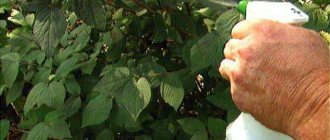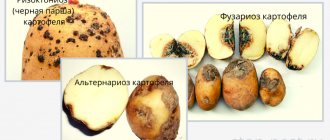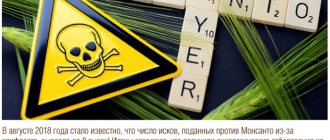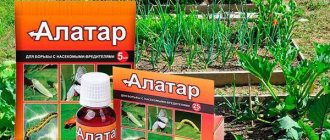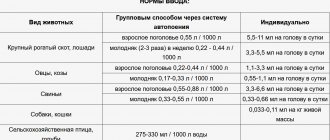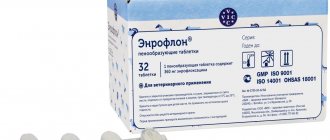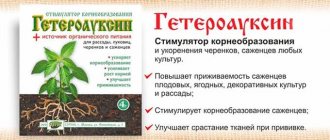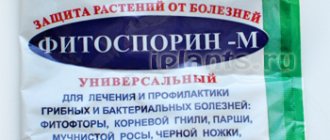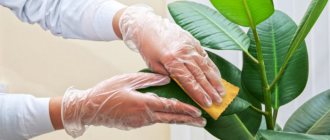Composition and mechanism of action of the drug Horus
The main active ingredient in the antifungal drug is cyprodinil. It belongs to the organic compounds of the aminopyrimidine class. For 1 kg of fungicide there are 750 g of active ingredient.
Cyprodinil penetrates the cells of pathogenic fungi and inhibits the synthesis of amino acids occurring in them. As a result, the vital activity of the parasites is disrupted, which leads to the cessation of the growth of mycelium on vegetation.
Important! The active substance of Horus, as indicated in the instructions for use, is effective only on young plants and trees. Therefore, cyprodinil will not be able to help an adult tree or shrub older than 3 years, since it will not be able to penetrate deep into their structure.
Among the pathogenic fungi on which the fungicide has a detrimental effect are:
- basidiomycetes;
- ascomycetes;
- deuteromycetes.
A feature of the systemic drug is its effectiveness, despite the humidity and air temperature. At the same time, it is safe for insects, fish, animals and humans.
How does the substance work?
Cyprodinil penetrates pathogen cells through the membrane and slows down the process of creating amino acids. As a result, the parasites can no longer act as actively as before and increase in number, which leads to the growth of the mycelium stopping.
Important information!
The substance shows 100% results only when treating young plantings, but, unfortunately, it is ineffective on vegetation aged 3 years and older. He simply won't be able to get inside the structure.
Horus - Effective control of plant diseases - video
The list of pathogens for which Horus is dangerous includes:
- deuteromycetes;
- basidiomycetes;
- axomycetes.
Humidity and elevated ambient temperatures do not reduce the effectiveness of Horus, and at the same time, it does not pose any danger to wildlife.
Scope of application
Horus is a plant treatment drug that is most often used to treat fruit bushes, trees and grapes. The active component of the product is used in personal and agricultural applications for the treatment of various fungal diseases, including:
- Alternaria blight. A disease that affects vegetables, shrubs, fruits, fruit trees and berry plants.
- Moniliosis. It is a widespread disease that primarily affects fruit trees. At the same time, shrubs suffer from the disease less often. The first symptoms of the disease are drying of branches and leaves, dying off of inflorescences. Pathology can lead to significant damage - a reduction in yield by 70 - 80%.
- Powdery mildew. As indicated in the instructions for use, Horus fungicide copes with white bloom on grapes and roses.
- Scab. A contagious disease that spreads quickly on trees. Expressed in the form of spots on foliage and fruits.
- Rot of grape berries. An insidious fungus that can spread to the bunches during their flowering, as well as to the berries and wood themselves.
- Monilial burn. Most often, stone fruit crops, especially cherries, are affected by this disease.
The drug Horus has a wide spectrum of action, which is indicated in the instructions for use, so the fungicide should always be in the gardener’s “first aid kit”.
Feedback on using the product
Sergei, 48 years old: “I recently became acquainted with the drug Horus. I learned about his active action from a neighbor in the country. Having diluted the drug according to the instructions, I sprayed the apple trees affected by scab. A week later I repeated the treatment. After this, the spots on the leaves and fruits disappeared, the branches became clear. I was pleased with the product."
Vladimir, 52 years old: “I bought a drug in a specialized store to prevent fungus on trees. The remedy turned out to be effective. Several treatments of the cherry were enough to prevent the initial stage of the fungus from spreading to other trees and affecting the entire garden.”
Ekaterina, 43 years old: “I have been using Chorus for two years in a row to prevent rot on strawberries. Before this, gray rot formed on the berries, and we didn’t even see the harvest. After using the drug, the rot went away, the berries began to swell in the sun. The harvest was rich. A kilogram package is enough for three years of use, so the product is economical.”
Thanks to the Horus fungicide, it is possible to protect the garden, vegetable and berry crops from fungal diseases that are not so easy to treat. This low-toxicity for humans and economically used drug has gained popularity among gardeners and gardeners.
Advantages and disadvantages
The instructions for use contain not only information about the composition and use of the Horus fungicide. The description of the benefits of the product notes the following:
- Possibility of using the fungicide even at air temperatures less than +10 °C.
- Fast absorption of the active substance. After treatment, the product penetrates into the plant structure in just 2 - 3 hours.
- Safety. The fungicide is non-toxic to most insects, birds, animals and people. It also has low toxicity to the inhabitants of the reservoir.
- Possibility of combination with other agricultural pesticides.
- Convenient packaging.
- Clear instructions for use.
- Economical.
- Groundwater safety.
The disadvantages of the fungicide include:
- Locality of impact. The product does not spread throughout the entire plant at once, but works only in certain areas of it.
- Difficult penetration. Cyprodinil is not able to pass through the thick skin of leaves that mature shrubs and trees have. Therefore, the drug is recommended for use on young crops, which is also reflected in the instructions for use.
- Carrying out treatment during the growing season of the plant. It is worth considering that Chorus is effective only at temperatures ranging from +3 °C to +25 °C.
Compatibility with other drugs
Chorus can be used together with other means with a similar effect. To protect plants from weevils and leaf beetles, they are used together with the insecticide Actellik 500. The combination of Horus with other fungicides promotes a speedy recovery of the plant. The drug is also compatible with the following drugs: Topaz, Skor, Aktara, Sumition.
Topaz
Before mixing Horus fungicide and using it, you need to do a little testing. To do this, mix the products in a container and leave for 2-3 hours. If after this time there is practically no sediment, or it is similar to the usual sediment, then the insecticides are compatible with each other.
Preparation of solution and dosage
Chorus is actively used in gardening. The effectiveness of the drug depends entirely on how correctly the working solution is prepared. Therefore, before applying the composition, you should carefully read the instructions for using the fungicide.
Important! The working solution must be prepared immediately before use; during storage it loses its properties.
Instructions for diluting the composition:
- The container in which the fungicide is prepared should be filled ¼ full with clean, settled water.
- Then it is necessary to introduce the drug into it, according to the dosage for the specific crop being treated, specified in the instructions for use.
- Mix.
- Add the remaining water.
- Mix thoroughly until smooth.
- Start spraying.
The instructions for use indicate the exact dosage of the product, which depends on the type of crop being treated.
| Fruit crop | Possible pathologies | Dosage of the drug |
| Plum, cherry, peach, apricot, sweet cherry, etc. | Leaf curl and monilial burn. | 2 g of Horus per 10 liters of water. |
| Clusterosporiasis, coccomycosis, fruit rot. | 2 g per 5 - 6 liters of liquid. | |
| Pear, apple, quince, other shrubs and trees with achenes in the fruits | Scab, fruit rot (moniliosis), Alternaria blight. | 2 g per 10 liters of water. |
According to the instructions for use, the consumption of the working composition depends entirely on the size of the crop being treated. As a rule, one shrub or tree accounts for 2 to 4 liters.
Important! Horus treatment of stone fruit crops should be carried out only in the evening.
What is it used for?
The instructions for use of the drug “Horus” (fungicide) recommend using it for monilianol burn of stone fruit trees, which include cherries, sweet cherries, apricots, plums, cherry plums and peaches.
The product is effective against coccomycosis, clasterosporiasis, scab, powdery mildew, fruit rot, leaf curl, gray rot, oidium, mildew, white and brown spot, gray rot, leaf spot.
The instructions for use with the drug "Horus" (fungicide) recommend treating various varieties of grapes, strawberries, wild strawberries, rose bushes and lawn grass.
When and how to use Chorus
Horus is an indispensable garden tool. The treatment procedure is carried out by spraying. It is important to follow the deadlines specified in the instructions for use. Usually the fungicide is used several times. The first treatment is before the flowers bloom, the second is 10 - 14 days after the flowering period, the third is 15 days before harvest.
Since the instructions for use indicate that the fungicide does not work at temperatures above +25 °C, it is recommended to spray in cool times - at +3 °C to 10 °C.
Important! The protective effect of Horus lasts for 10 days.
Fruit trees
Chorus is actively used against diseases of fruit trees such as powdery mildew, Alternaria, scab, and monilial blight. Treatment must be carried out twice - during bud break and 2 weeks after flowering.
To preserve the fruits and increase their shelf life, it is worth spraying the tree 15 days before harvesting. This point is also reflected in the instructions for use and should not be ignored, since the safety of the fruit for human health depends on it.
It is better to spray fruit trees with Horus at the first signs of the disease or as a preventive measure.
Coniferous trees
Coniferous plantations often suffer from browning. The fungicide Horus will also help to cope with this problem, treatment with which should be carried out in the spring, when shoot growth begins to increase.
Roses
Fungal diseases and ashtray can be cured by using Horus at the stage of setting buds on the bushes. It is important to take into account that the effectiveness of treatment depends on the ambient temperature. The instructions for use indicate that roses should be sprayed during a period when the average daily temperature does not exceed +10 °C.
Strawberries and wild strawberries
Strawberries and strawberries can suffer significantly from gray rot, spotting and powdery mildew. In this case, infection can even occur from last year’s foliage that remained on the site. Spraying with Horus fungicide will help cope with the problem.
The treatment is carried out three times. According to the instructions, the dosage depends on the time of the procedure:
- The first use of the drug should be before tying buds. The working solution contains 6 g of substance per 10 liters of water.
- The second treatment is appropriate during the period of berry formation. The mixture consists of 10 liters of water and 3 g of Horus.
- The third spraying is carried out after harvesting. The dosage corresponds to the first treatment (6 g/10 l).
Grape
According to the instructions for use, Horus can be used to protect grapes from gray rot, downy and powdery mildew. In this case, the working solution for spraying must be more concentrated than for other crops.
Instructions for grape dosages:
- Primary treatment during the period of bud formation – 6 g/5 l of water.
- Secondary spraying is carried out when the clusters are formed - 5 g/5 l.
- The third treatment is carried out when the berries ripen - 6 g/5 l of water.
Attention! The drug Horus for grapes should be used only in calm and dry weather. Each leaf must be processed on all sides.
Processing terms and rules
Treatment with Horus in the spring is recommended. After the snow melts and weather conditions become stable, stone fruit crops must be provided with good protection against diseases of fungal origin.
Spring treatment is effective due to low temperatures. All activities should take place either early in the morning or in the evening. Humidity should not be high, the absence of wind and rain is an additional bonus for the effectiveness of drug absorption.
Fruit trees
Most often in gardens you can find stone fruit crops such as cherries, sweet cherries, and apricots. Preventive treatment of such trees is needed for monilial burn. Spraying activities take place during the growing season and at the flowering stage. The second time after 7-10 days.
If there are signs of disease, the crop is treated immediately to prevent fungus or rot from developing. Repeat the procedure with Horus no earlier than 14 days later. But no later than 2 weeks before harvesting the fruits. Plums are processed in a similar way.
Apple and pear trees are processed similarly to the previous method. Prevention should take place twice in the spring; before and after flowering. Estimated consumption per hundred square meters = 10 liters of working fluid.
Precautionary measures
Like any other chemical, Horus fungicide requires compliance with safety instructions when using it:
- Spraying must be carried out in protective clothing, using goggles, a mask and gloves.
- If the product gets into your mouth, you should immediately take activated charcoal.
- When in contact with the drug, eating and smoking are not allowed.
- After treatment, you must wash your hands and face with soap, wash your clothes and dispose of the containers used for the solution.
- Fungicide waste is removed to places inaccessible to people and animals.
Category: “Questions and answers”
Question No. 1. What fungicides can replace Horus?
Answer.
An equivalent replacement for this drug, a product that contains the same active ingredient. This is the Guardian fungicide, produced by domestic manufacturers. Unlike granular "Chorus", it is distributed in the form of a concentrated suspension.
Question No. 2. What can Chorus be combined with?
Answer.
When combined with other drugs, there is a complete combination with “Skor” → how to use and “Topaz” → application + reviews. When used together, it is necessary to take into account that these fungicides are used only at temperatures +140 – +250.
Other products must be tested before use in tank mixtures. Each pesticide is dissolved in a small amount in 0.5 liters of water. Pour into a common container one by one and leave for two hours. If the color of the mixture has not changed or flakes have not appeared, it means that the drugs are compatible. Although the final result will become known when the “cocktail” affects pathogens and pests.
Analogues of the drug Horus
Horus fungicide has clear and simple instructions for use, in which you can find out the dosage for a number of crops - peach, apple, strawberry, etc. It is noted that the one-component preparation can be combined with other pesticides to increase the effectiveness of treatment.
Like any remedy, Horus has several analogues, which differ in the active substance and spectrum of action. Among them are:
- Champion. This Fungicide, the main active substance of which is copper, is used for the treatment and prevention of fungal pathologies. But, unlike Horus, it can also be used for nightshade crops and hops.
- Angio. The fungicide contains two active substances at once, so it can be used to treat not only fungal infections, but also viral and bacterial diseases. At the same time, it is actively used to combat various types of agricultural pests.
Advantages of Horus fungicide
- The ability to penetrate into young leaves or fruits through the intercellular space and act from the inside for the purpose of prevention over a long time;
- The active substance penetrates into the cells of plant leaves within a short time;
- Moisture resistance;
- Does not lose its effect on pathogens even at low air temperatures;
- In the case of late spraying, shortly before the start of harvesting, the fruits are neutralized, which improves their storage and reduces losses from rot by 40%;
- Does not cause phytotoxicity;
- Economical, consumption rate is significantly less than other fungicides;
- Good compatibility with almost all drugs, especially with those containing penconazole, difenoconazole, captan, copper oxalate, however, a compatibility test is a prerequisite;
- Safety, toxicity class 3 according to WHO classification.
Terms of use: choosing the best time for processing
If you follow the instructions, the Horus fungicide can stop the infectious process and prevent its appearance on healthy fruit trees.
Manufacturers note that it is equally effective in spring and summer. Spraying on fruit trees can be carried out immediately after the last frost, when the thermometer does not fall below +3º C.
Please note: in hot weather, it is useless to spray the Horus fungicide. The effect of action decreases noticeably with warming to +18/+25º C and above.
The drug is most effective against scab and other infections in the interval between the green cone phase (the initial stage of bud break) and until the end of flowering. Spraying twice during this period provides good prevention and a successful start to the growing season.
It is advisable to process fruit trees in the morning and evening hours in the absence of wind or its low speed - no higher than 4-5 m/s.
Features of use
Chorus is most active at low temperatures (+1-3 degrees). After spraying, the medicine begins to actively fight pathogens from inside the plants within two hours. At the same time, it is not washed off by precipitation, but its effect quickly weakens in clear sunny weather and temperatures above +22 degrees. Since Horus is active at low temperatures, while most fungicides “work” at higher temperatures, it is extremely popular not only among private owners, but also at agricultural enterprises. It can be successfully used in early spring, when moniliosis is rampant among fruit and stone fruit crops.
As the instructions for the drug suggest, Horus is compatible with most fungicides. Moreover, this combination with other active substances contributes to the rapid recovery of the sick plant. Horus performs especially well in combination with drugs such as Skor and Topaz.
The drug is stored in sealed packaging for several years, provided that the room temperature is between -10 and +35 degrees. Spraying is allowed only with freshly prepared solution. The remaining liquid is not stored, but disposed of.
Release form of “Horus”, difference from counterfeit
This fungicide is a relatively new Swiss development intended for fruit trees. It goes on sale in convenient packaging - in bags of 1, 3 and 15g, as well as in a large package of 1 kg.
Like most effective drugs, Horus is actively counterfeited. There are two ways to distinguish an original from a counterfeit:
- The bag of this product contains a holographic marking that is visible when the viewing angle changes.
- The original granules dissolve instantly, without any residue. The fake is difficult to dilute, tends to the bottom, and forms sediment.
You should not count on the effective and safe action of a powder of unknown origin, so be careful during the purchasing process.
